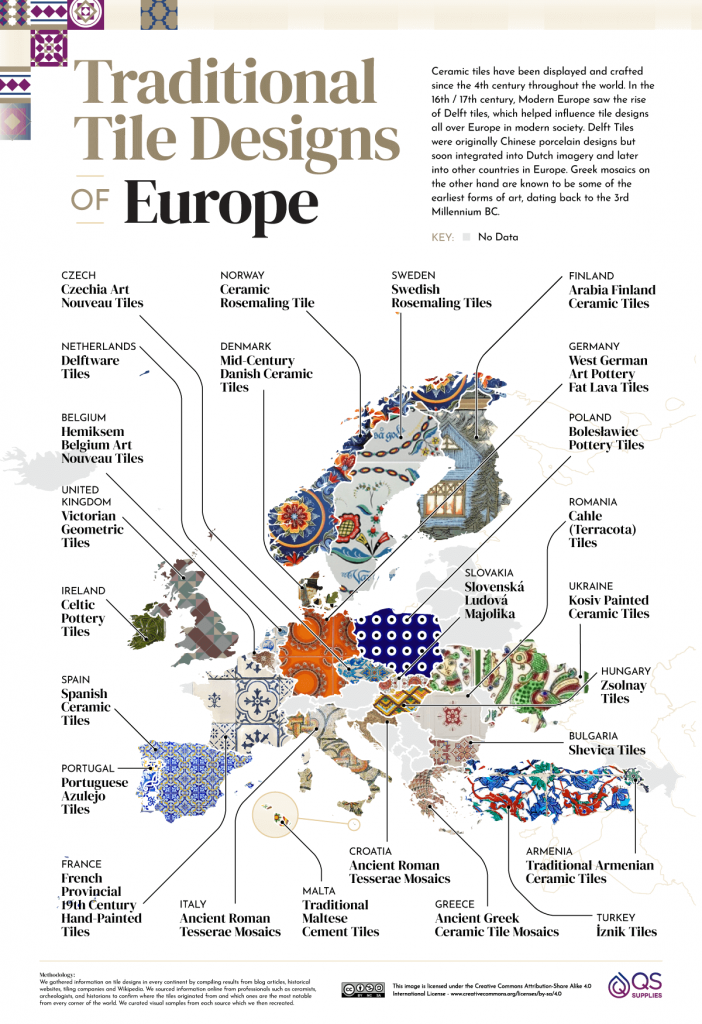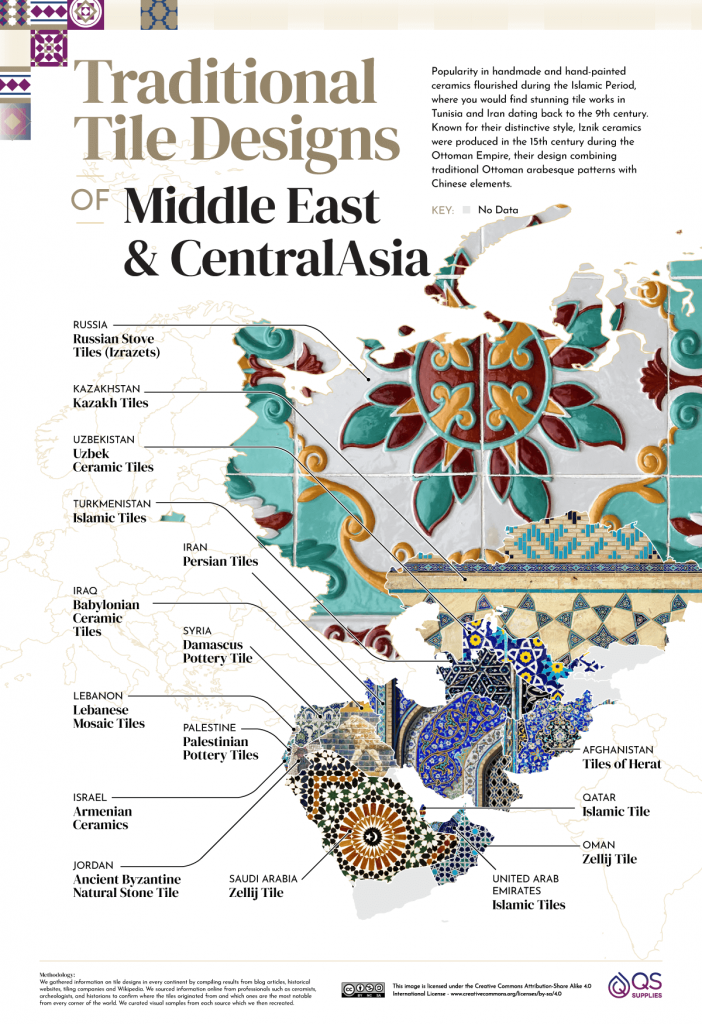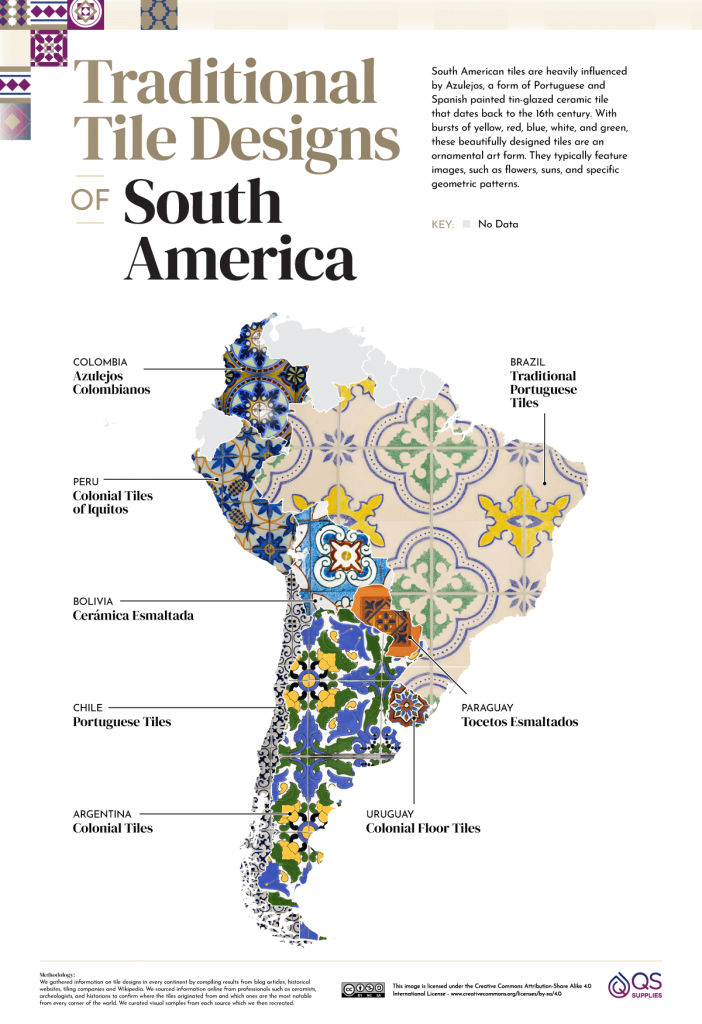The Miniature Rooms of Narcissa Niblack Thorne
The Thorne miniature rooms are the brainchild of Narcissa Thorne, who crafted them between 1932 and 1940 on a 1:12 scale. Incredibly detailed and...
Maya M. Tola 27 May 2024
Traditional Tile Designs of the World, the result of a UK design wholesaler’s marketing efforts, presents a colorful display of tile designs from over 80 nations around the world. Mainly—but not exclusively—involving vivid designs in glazed ceramic tiles, the patterns chosen range from ancient to modern and come from every continent except Antarctica.
Although Traditional Tile Designs of the World clearly exists to sell tile, it is also a fun diversion for the art or design lover. Tiles and their other pottery cousins appear in many art museum collections, but only a rare few become major attractions. Most of us tend to pass over tiles in favor of flashier offerings, so it is nice that they get starring roles here.

A map of traditional tile designs of Europe. Image via QS Supplies (CC BY-SA 4.0).
In many cases, the tile designs come from more extensive pottery traditions, such as Asian porcelain and Mediterranean majolica. Therefore, some of the tiles on the list will appear familiar to our readers, especially China’s famous Ming porcelain and its younger sister Dutch Delftware. Unsurprisingly, examples from the Islamic world are particularly eye-catching. Luxury products like Turkey‘s famous Iznik tiles, with their elaborate geometric motifs, frequently decorate both the interiors and exteriors of celebrated mosques.
However, lesser-known tiles from South and Central America are also vivid and engaging with their bright colors and bold (often floral) motifs. The European selection includes everything from classical mosaics—popular in the ancient and medieval worlds and closely related to more familiar rectangular tiles—to Victorian, Arts and Crafts, and even 20th-century designs. After all, tiling as a design choice really took off in the Western world during the Victorian era. And then there are a few surprises. Eritrean Tierra Negra (black clay) pottery and Lapita Ware (ceramic with intricate stamped designs) from Fiji were both welcome revelations to me.

A map of traditional tile designs of the Middle East and Central Asia. Image via QS Supplies (CC BY-SA 4.0).
The tile designs appear in a series of maps with tile patterns superimposed over the countries, an illustrated list, and a slideshow searchable by country or continent. What this project lacks, however, is information. After catching the viewer’s interest, the website gives little opportunity to learn about the tile traditions included. That is not too bad when there is a specific name you can Google (Korean Goryeo tiles, for example), but others are too vague (googling “Nigerian Broken Tiles” got me nowhere). Nor do we learn much about how and why each pattern was chosen to represent its nation. The website mentions sources ranging from scholars to blog entries to social media posts, but the few links given tend more toward the commercial than the educational.
That being said, the tile designs included are fantastic, so this website is well worth a look. It definitely inspired me to learn more about the history of ceramic and tile production worldwide. Similarly, it is not hard to imagine the project succeeding in its intended purpose of inspiring people to buy tile.

A map of traditional tile designs of South America. Image via QS Supplies (CC BY-SA 4.0).
This map was commissioned by GS Supplies, a UK bathroom supply company, and brought to life by NeoMam Studios, the visual content producer responsible for some other projects we have enjoyed here at DailyArt.
DailyArt Magazine needs your support. Every contribution, however big or small, is very valuable for our future. Thanks to it, we will be able to sustain and grow the Magazine. Thank you for your help!